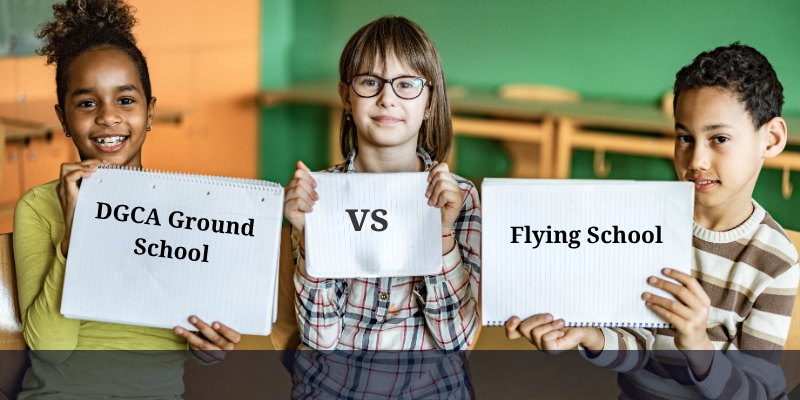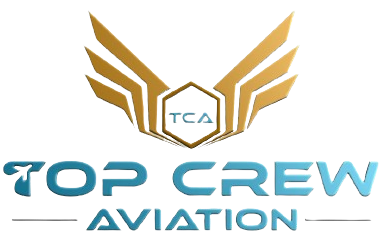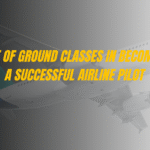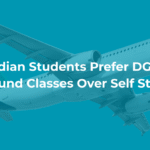
Do you dream of becoming a commercial pilot in India? If yes, then you’ve likely come across two very important terms during your research: DGCA Ground School and Flying School. While both are essential for a pilot’s journey, they serve very different purposes.
Many aspiring pilots mistakenly believe that ground school and flying School are interchangeable—but that’s far from true. Understanding the difference between DGCA Ground School and Flying School is vital for planning your aviation career the right way.
This blog will walk you through the key differences, importance, course content, cost, career value, and how both these institutions work together to make you a certified commercial pilot.
What is DGCA Ground School?
Ground school is the first step in becoming a pilot. It is where you learn the theoretical knowledge required for passing DGCA exams. These exams are mandatory if you wish to obtain a Commercial Pilot License (CPL) or even a Private Pilot License (PPL) in India.
Subjects covered in DGCA Ground School:
- Air Navigation – Understanding coordinates, directions, compass use, maps, and calculations to fly accurately.
- Aviation Meteorology – Studying the atmosphere, weather systems, and how they affect flying conditions.
- Air Regulations – Learning the rules of flying, aircraft operations, and pilot responsibilities.
- Technical General & Technical Specific – Understanding how aircraft systems work, engines, instruments, and performance.
- Radio Telephony (RTR) – Training on communicating with Air Traffic Control (ATC) using aviation terminology.
This part of pilot training is academic. It’s conducted in classrooms or online and includes regular tests, mock exams, and lectures.
What is Flying School?
Flying School is where the real-world training begins. Once you’ve mastered the theory in ground school and passed your DGCA exams, you move on to actual flight training under the guidance of certified flight instructors.
Flying schools in India must be approved by the Directorate General of Civil Aviation (DGCA) to offer valid flight hours for CPL or PPL.
What happens at a DGCA-approved flying school?
Flying school is where you learn how to fly an aircraft step by step. Here’s what happens:
- You start with dual flights (with an instructor) to learn basic flying skills
- After that, you fly solo to build confidence
- You must complete 200+ flying hours for a CPL license
- You use simulators to practice difficult situations
- You do navigation and cross-country flying
- You learn night flying, emergency handling, and how to manage the cockpit
- By the end, you’re fully trained to fly as per DGCA rules
Key Differences Between DGCA Ground School and Flying School
Let’s break down the comparison clearly in terms of structure, purpose, and outcome:
| Feature/Aspect | DGCA Ground School | Flying School |
| Objective | Prepare for DGCA theory exams | Train for real aircraft operation |
| Content | Theory: Navigation, Met, Regulations, RTR | Practical: Take-off, landing, navigation flights |
| Learning Mode | Classroom or Online | Aircraft-based + simulator |
| Duration | 3 to 6 months | 2 to 18 months (based on weather, availability) |
| Certification | DGCA exam certificates (5 papers + RTR) | Flying logbook + PPL/CPL license |
| Instructors | Ground instructors (aviation experts) | Certified Flight Instructors (CFIs) |
| Eligibility | 10+2 with PCM, Age 17+ | Must pass DGCA exams first, Age 17+, Class 1 Medical |
| Cost | ₹1.5 – ₹2.5 lakhs (avg.) | ₹35 – ₹50 lakhs (avg.) |
| DGCA Approval Needed? | Yes | Yes |
Ground school vs flying school: Why both matter
You cannot become a pilot with only flying skills or only theoretical knowledge. Both ground school and flying School are legally and practically necessary for obtaining a DGCA-issued pilot license in India.
Here’s why:
Ground School is Required Because:
- DGCA requires candidates to pass theoretical exams before licensing.
- Without clearing these papers, you can’t appear for the final flying test (skill test).
- You need theory to understand how to manage weather, read instruments, or follow rules while flying.
Flying School is Required Because:
- Only a flying school can help you log the minimum 200 hours of flying experience needed for CPL.
- It teaches you how to control the aircraft, respond to emergencies, and fly across different weather conditions.
- Without practical training, your knowledge is incomplete and unusable.
Remember: Even the best student pilot must pass both theory and flying tests before becoming a licensed pilot in India.
Which Comes First – Ground or Flying School?
The logical and most preferred order is:
- Ground School First: Because you must clear DGCA written papers before applying for your skill test (flying test).
- Flying School Second: After DGCA clearance, you enroll in a DGCA-approved flying school to complete your flight hours and simulator training.
Many flying schools offer both services under one program, but some students prefer to attend ground school separately for more focused exam preparation.
Fee Structure—Ground School vs Flying School
Let’s understand the financial aspect of pilot training.
Ground School Fees:
- Range: ₹1.5 to ₹2.5 lakhs
- Includes: Books, lectures, mock tests, doubt sessions, exam guidance
Flying School Fees:
- Range: ₹35 to ₹50 lakhs
- Includes: Aircraft rentals, flight instructor fee, simulator time, fuel, accommodation (sometimes)
Combined CPL Program:
Some schools offer a combined CPL program (Ground School + flying school).
for around ₹45 to ₹55 lakhs.
Always ask whether the school offers combined or separate training before enrolling.
DGCA Approval—Must for Both
In India, only schools approved by the Directorate General of Civil Aviation (DGCA) can conduct valid training and issue acceptable certificates.
DGCA Requirements for Approval:
- Qualified instructors and faculty
- Modern training aircraft and simulators
- Proper safety protocols
- Accurate maintenance of student logbooks and records
You can check the official DGCA-approved list of schools here.
Top Ground & Flying Schools in India
Ground Schools:
- Top Crew Aviation – Delhi & Jaipur
- Capt Sahil Aviation (Online & Offline Programs)
- Indira Gandhi Institute of Aeronautics
- Capt Sahil Khurana Aviation Academy
Flying Schools:
- Top Crew Aviation – Delhi & Jaipur
- Offers a complete CPL program with high placement support and modern simulators.
- IGRUA (Indira Gandhi Rashtriya Uran Akademi) – Govt-funded, prestigious School.
- Chimes Aviation Academy – MP-based with modern aircraft.
- NFTI (National Flying Training Institute) – Maharashtra.
Career Outcomes—After Ground School & Flying School
After Ground School:
- You receive DGCA exam passing certificates.
- It makes you eligible for flying training and later, the skill test.
- Adds strong academic base that helps throughout your flying life.
After Flying School:
- You earn a CPL (Commercial Pilot License) or PPL.
- You become eligible to apply to:
- Commercial airlines (IndiGo, Air India, etc.)
- Charter services
- Government or defence flying roles
- Flight Instructor jobs
Pro tip: Choose schools with career assistance and airline tie-ups to improve your job prospects.
Common Myths – Busted!
❌ Myth #1: Ground School is optional.
Truth: Without it, you can’t clear DGCA exams or get a license.
❌ Myth #2: I can start flying before clearing theory.
Truth: You must clear ground exams before you can give final CPL check rides.
❌ Myth #3: Cheapest School is best.
Truth: Quality of aircraft, instructors, safety, and success rate matter more than cost.
Tips for Choosing the Right School
Here’s what you should check before enrolling in either ground or flying school:
- DGCA Approval Certificate
- Experienced Instructors
- Fleet of aircraft & simulators
- Exam support, mock tests, and material
- Placement support & industry tie-ups
- Student reviews and success stories
Conclusion: Two Steps, One Destination
Becoming a pilot is a journey made up of two critical phases—DGCA Ground School and Flying School. They are not the same, but they complement each other. Without ground school, you can’t pass the exams; without flying School, you can’t apply your knowledge in the skies.
If you’re serious about your aviation dreams, choose a school that offers both strong theoretical coaching and high-quality flying training under one roof—like Top Crew Aviation or similar DGCA-approved institutions.
The skies await. But to get there, your foundation must be solid on the ground—and in the air.
Ready to Take Off?
Begin your journey with the right School. Learn, fly, and achieve your dream of becoming a pilot in India. Reach out to a DGCA-approved institute and make your dream career a reality.
URL Suggestion:
Best Strategy to Clear DGCA Air Navigation
How to get Private Pilot License (PPL) in India
How to Become a Pilot in India
Frequently Asked Questions
No FAQs found.



